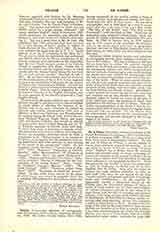
Philibert de L’Orme
Celebrated architect of the French Renaissance, b. at Lyons, c. 1515 or a little later; d. at Paris, January 8, 1570

De L’Orme, PHILIBERT, celebrated architect of the French Renaissance, b. at Lyons, c. 1515 or a little later; d. at Paris, January 8, 1570. Of the exact date of his birth there exists no documentary evidence. He was the son of Jehan de L’Orme, a master builder of Lyons, from whom he received his training. At an age when he speaks of himself as being “of great youth” Philibert was at Rome, where his curiously careful and scientific study of classic antiquities attracted the attention of the learned Cardinal of Santa Croce, then a bishop, later Pope Marcellus II, through whose influence he was employed by Paul III. From this service he was recalled to Lyons two years later, in 1536, by Guillaume du Bellay and his brother, Cardinal Jean du Bellay. Soon after his return de L’Orme was made military controller, an office he held until 1545, when he was named by the king “master architect and general conductor of buildings, works and fortifications.” In this capacity he ingeniously averted a threatened attack of the English upon the dismantled chateau of Brest by means of mock cannon and an improvised soldiery. At various subsequent periods, he was endowed by royal favor with the title of counsellor and almoner ordinary of the king, and was made Abbe of Geveton, of Barthelemy, of Saint-Eloy-les-Noyon, besides receiving other such sinecures; he was also appointed a canon of Notre-Dame at Paris. Though it was the usage of the time for the king to bestow upon laymen the title and benefices of an abbe as reward or salary, it has been conjectured from the double title of king’s almoner and canon of Notre-Dame, that de L’Orme had received minor orders. Between the years 1541 and 1559, during which he held the position of royal architect under Francis I and Henry II, de L’Orme altered, enlarged, and restored numerous chateaux, notably those of Villers-Cotterets, Saint-Germain-en-Laye, Fontainebleau, and Vincennes. His first individual achievement of importance, however, was the chateau of Saint-Maur-les-Fosses, originally designed for Cardinal du Bellay, Bishop of Paris, but afterwards taken over by Catherine de’ Medici. Of this notable work almost nothing remains. In 1552 the chateau d’Anet, regarded as the best example of de L’Orme’s genius, was begun for Diana of Poitiers, mistress of Henry II. Benvenuto Cellini‘s famous bronze Diana, now in the Louvre, was executed for this building and other eminent artists assisted in its decoration.
The death of Henry II (1559) marked the turning-point of de L’Orme’s prosperity. His large revenues, as well as his rugged independence had made for him envious and contentious enemies, not the least formidable of whom was the poet Ronsard. During the period of unpopularity which succeeded he issued, in 1561, the work “Nouvelles inventions pour bien bastir et a petits fraiz” (How to Build Well and at Small Expense). This was subsequently a part of his notable treatise on architecture which contains much lively autobiography; the first volume of this work appeared at Paris in 1567 under the title: “Le premier tome de l’architecture de Philibert de L’Orme”. In 1564 he laid the foundations of the historic chateau of the Tuileries for Catherine de’ Medici. The initial part of the structure, however, suffered a complete change under other hands. The Tuileries was the last important undertaking of the architect, who was buried with the honors of a canon of Notre-Dame. The claim has been made by some biographers that de L’Orme designed for Saint-Denis the Valois Chapel, now destroyed; there is much doubt as to his exact share in various other works with which he is known to have been associated. The only great work of de L’Orme now actually remaining is the tomb of Francis I in Saint-Denis at Paris.
CHARLES D. MAGINNIS

